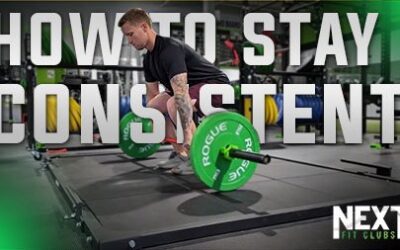With the New Year right around the corner, lots of us are starting to think about the changes weâd like to make over the next year to become better versions of ourselves.
Many of us will make goals this year to be more active, eat better, and take better care of our bodiesâ and this can seem like a challenging task.
New Yearâs resolutions can be difficult to stick to, so this month I want to give you some tips on keeping that resolution all year round!
Making Appropriate Goals
With New Year’s resolutions, or any type of long term goal, adherence is key. While we may want to see big changes, itâs important to set goals that are achievable yet challenging. If our goals are inappropriate for our current skill set it can quickly become frustrating and make it hard to stick to the plan.
In terms of new fitness goals, this means we donât want to push ourselves too hard too fast. This can lead to injury, prolonged recovery time, and itâs usually not enjoyable. If youâre just starting to get back into exercise, start slow with movement styles you enjoy doing!
Remember, you donât need to be in the gym every day for hours to see results, but you do need to implement the concept of progressive overload.
Progressive overload simply means increasing the stress placed on the body over time. So, if we were previously relatively sedentary, adding small amounts of exercise that increases in difficulty each week will help us meet our goals.
We can apply this concept to almost any goalâ for example, if your New Yearâs resolution is to improve your nutrition, you could start by making small changes to your diet like swapping out soda for water or switching to leaner protein sources. Implementing these gradual changes one week at a time will make it easier to adjust and adhere to the plan to reach your long term goal.
The type of goal we set is also important. Larger goals may seem daunting, and can often be demotivating, especially if we feel we are not making progress at a quick enough pace. To avoid the âresolution drop outâ I would suggest making several smaller goals that you can achieve over the course of the year. Setting a new specific fitness goal each month can help keep you engaged in your fitness journey and help you implement that concept of progressive overload appropriatelyâ that is, slowly over time!
Monitoring Progress
It can take a long time to feel like we are on our way to reaching our goals, especially when they are fitness related. Both weight loss and muscle gain take plenty of time and consistent effort to achieve, and it can be frustrating when we feel like weâve already put in hours of work but have not yet reached our end goal.
Monitoring your progress is a great way to remind yourself you are on your way to achieving those goals, even if progress is slow at first. Seeing how far you have come each week can seriously help motivate you to keep it going, so I encourage you to try and track your progress if you haven’t before.
Progress monitoring can also be a good way to let us know when we need to try something different when progress starts to stall.
Remember, plateaus in your progress are not always a bad thingâ it means your body has adjusted to your current training regimen and is ready for a new challenge! (hint, more progressive overload!)
For fitness-related goals there are a few different ways to monitor your progress:
-
Weight Tracking: If your overall goal is body fat loss, this may be an appropriate option for you. Almost everyone has a scale in their house, making tracking standard body weight an easy and accessible option for most people, but there are some important things to keep in mind: specifically, that muscle tissue is heavier than fat tissueâ so donât panic if youâve been hitting the weights hard and donât seem to lose body weight, odds are youâve been losing body fat and gaining muscle mass (which results in an overall higher body weight).
-
Body Composition Tracking: Body composition measurements give a little more insight into what your body is made up of: muscle or fat tissue (or bone mass). This can be helpful for individuals with more specific training goals, or anyone who wants to make sure their weight training program is helping them build lean muscle mass. There are a few different types of body composition measurement tools, these include the DEXA scan, skinfold assessments, and the InBody scan, which we even have at our club in Hillsborough!
-
Performance Monitoring:  Performance monitoring may be one of the most useful and easy self-check-in tools out thereâ you just need yourself! Monitoring your fitness progress along the way is a great way to avoid the dreaded fitness plateau and give purpose and direction to your workouts. Try grabbing a notebook or digital notepad and recording your workout progress over the first few weeksâ and remember: youâll still need to progressively overload đ
Keep in mind these are not the only ways to monitor your progress. If your New Yearâs resolution is not directly fitness related, find a creative way to track your progress! In most cases keeping some sort of journal can be helpful, just remember to record as much detail as possible and donât forget to log the date!
Making Meaningful Lifestyle Changes
A New Yearâs resolution is usually a behavior change weâd like to be able to keep up for the coming year, that means we want our resolution to become a lifestyle change. Lifestyle changes become habitsâ things that become part of our daily routine that we wouldnât think twice about. This takes TIME.
Progress is rarely linear, so donât get discouraged if you have an off week, or even an off month. Being able to get back on track after experiencing a setback is one of the most important parts of being able to create a lifestyle changeâ after all, life often hands us unpredictability.
That being said, having a plan is important, and having a back up plan can be even more important. Having a detailed plan with reasonable backups can help you feel more in control of your progress and help us cope with the hurdles we experience in everyday life. For example, if time is often a limiting factor for you, having a 20-30 minute HIIT workout alternative may be helpful for days when you find out you cannot get a full workout in. If nutrition is more your goal, doing some research and finding healthy restaurant options in your area for when you donât have time to cook can help you stay on track!
Getting Help
Donât be afraid to find support in your community! If youâre not sure where to start and need accountability, get yourself a trainer! A non-negotiable appointment with a fitness professional will ensure you stay on track each week. Group classes can also be great in keeping a schedule and finding a support system. Find friends, family members, or even make some new friends with similar goals and use that to motivate you along your journey toward your goal.
Having another person working alongside you helps keep you accountable, and with long term goals, accountability is also key. So if youâre not the type of person who likes to do things alone, this one is specifically for you! Finding a buddy to get you through those days when you may not feel as motivated can be one of the most helpful ways to keep yourself on track, not to mention, some friendly competition can get you to work a little harderâ so get your friends involved!





0 Comments